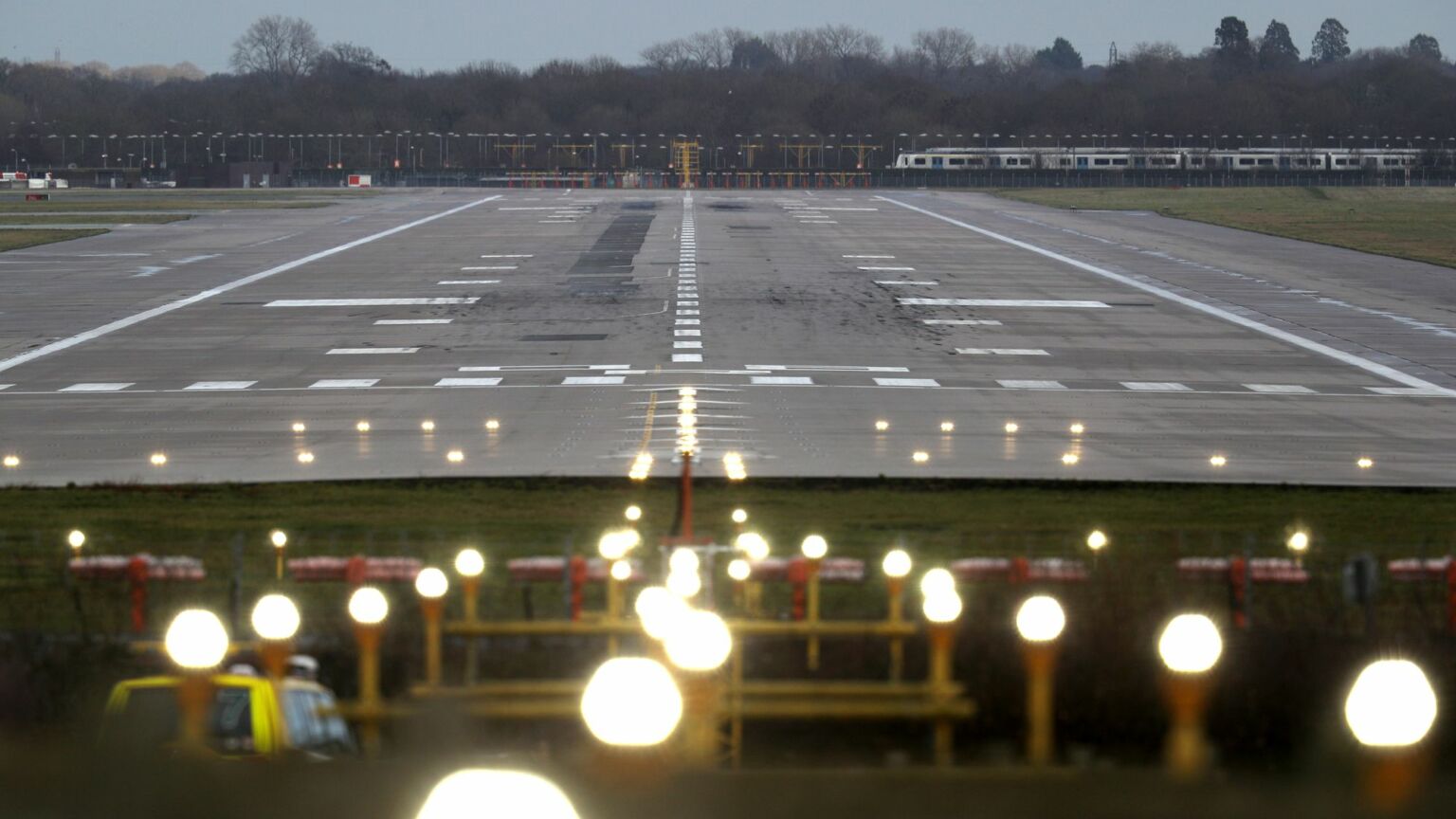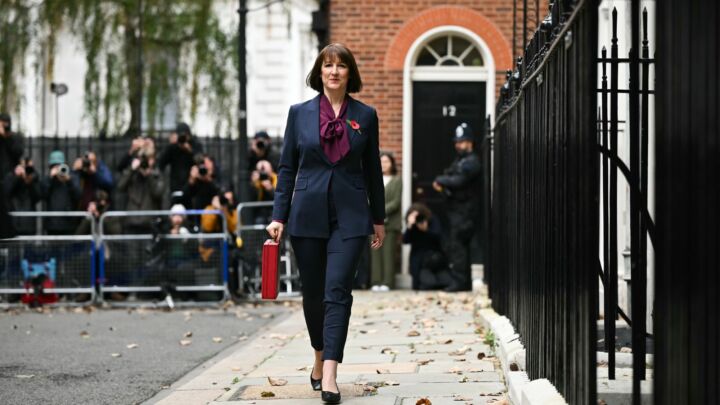The truth about the Gatwick drone incident
Five years ago today, the British authorities lost their minds chasing a drone that never existed.

Want to read spiked ad-free? Become a spiked supporter.
Five years ago this week, the British authorities lost their minds. London Gatwick, the UK’s second-busiest airport, was brought to a complete standstill for 72 hours. In the week before Christmas, around a thousand flights were cancelled or diverted. In total, over 140,000 passengers’ journeys were prevented or disrupted, ruining the holidays for thousands of families.
The official cause of the disruption was the dangerous incursion of a drone – or possibly multiple drones – on to the airport runway. But it has become abundantly clear in the years since that there was never any physical evidence of drone activity at the airport. Gatwick was shut down on the basis of an entirely imagined threat. And while this might sound like a curious chapter to return to, the Gatwick-drone-that-wasn’t was deeply revealing about officialdom’s capacity for hysteria.
The British authorities still insist that Gatwick was subjected to a malicious, sophisticated drone incursion. Sussex Police say they received 170 reports of drone sightings during the three days when the airport was closed, 115 of which they deemed to be ‘credible’ – not least as many came from airport staff and police officers themselves. An investigation involving five English police forces was launched. But it had to be called off after 18 months, as it could find no video or photographic evidence to corroborate the drone sightings.
Even in our age of ubiquitous smartphone cameras, not a single witness could provide an image of the drones. Professional photographers, with their superior equipment, fared no better. According to news photographer Eddie Mitchell, at least 30 of his fellow paparazzi were at the scene. Yet, as he told the Guardian in 2020, none caught a glimpse of the elusive drone. Mitchell thought he had snapped it, but when he later looked at his photos more closely the ‘drone’ turned out to be a police helicopter. Indeed, it is highly likely that many of the later reports of ‘drones’ were simply sightings of the police’s own aircraft.
Being an international airport, Gatwick is among the most heavily surveilled sites in the UK. And yet, none of those cameras captured anything pointing to evidence of a drone.
On the second day of the shutdown, Gatwick installed a specialist counter-drone system with the help of the British Army. This would have been able to detect a drone based on its radio signal. But nothing unusual was detected. The lack of evidence from the radio signals ought to have put an end to the wild-goose chase there and then. Instead, experts blamed the counter-drone system for allowing the alleged drone to slip through its net. And so the hunt for the drone carried on – and Gatwick remained closed for another day.
The kind of manoeuvres the ‘drones’ were supposedly performing ought to have aroused at least some scepticism from officials. For instance, not even a military-grade drone could have stayed in the air for more than 24 hours, yet the Gatwick ‘drone’ somehow managed to wreak havoc for three days straight. Witnesses also described a drone weaving in between the airport’s buildings, performing complex movements that were not only technologically implausible, but would also have required intimate knowledge of the airport’s layout. But the fact that these accounts were implausible only panicked the authorities further. The drone’s apparent ability to evade capture was held up as a sign of the sophistication of the ‘attack’ and of the superior technology of our adversaries.
In the years following the incident, drone enthusiast Ian Hudson has sent numerous freedom-of-information requests to police and to the Department of Transport, and journalist Samira Shackle carried out extensive interviews with eyewitnesses for a long-read in the Guardian. All of this research points to the same conclusion – namely, that there was no unauthorised drone at Gatwick Airport five years ago.
Although the drone might not have been real, the panicked reaction to it had very tangible consequences. The disruption of hundreds of thousands of flights cost the airlines hundreds of millions of pounds. EasyJet alone lost £15million from the three-day shutdown of Gatwick. The incident even prompted the government to fast-track stringent new laws to limit the activity of drones and other personal aircraft. Strikingly, a clause that would have exempted children’s toys below a certain size or weight was struck out of the legislation. This means that a child who flies a £15 toy helicopter in his or her back garden can now be fined £2,500 if they live within three miles of a licenced airfield.
No one was more adversely affected by the drone hysteria than married couple Paul Gait and Elaine Kirk. On 21 December, the third day of the drone disruption, 12 armed coppers raided their home. The next day, a photo of them was plastered on the front page of the Mail on Sunday. ‘Are these the morons who ruined Christmas?’, thundered the headline.
The extent of the evidence against Gait and Kirk seemed to be that Gait was a model-aircraft enthusiast. It quickly emerged that both were at work at the time of the initial drone sightings. What’s more, Gait did not even own a drone. Despite the vast 18-month police investigation, the married couple were the only people to have been charged over the drone incident. They have since been awarded £200,000 for damages and legal fees following their wrongful arrest.
The ‘morons who ruined Christmas’, it turns out, were not Gait and Kirk. They were the UK authorities, who acted as if several drones had been spotted, despite having no concrete, physical evidence to go on. They shut down an airport, arrested innocent people and even passed new legislation on the basis of what can only be described as an outbreak of hysteria. Instead of questioning the implausible accounts of drone sightings, instead of trusting their state-of-the art cameras and detectors, which had failed to corroborate what people believed they saw, they allowed themselves to believe the totally implausible, and to take drastic measures without any evidence to support them.
Outbreaks of official hysteria like this are not unheard of. David Clarke, an academic whose research specialises in urban legends, has likened the Gatwick-drone incident to the ‘phantom helicopter’ scare of the mid-1970s. Initially, security guards at a quarry claimed to have seen a helicopter flying low. Senior officers, and later the secret service, convinced themselves that there was an IRA plot to steal explosives from quarries using an unregistered helicopter. After the theory was heavily promoted in the media, with people primed to believe a suspicious helicopter was running amok, hundreds of new reports flooded in. Much like the Gatwick drone incident, many of the ‘suspicious’ sightings were actually of police aircraft that had been deployed to chase after the phantom helicopter. Investigations by special branch, the Ministry of Defence and two police forces all found no evidence of any unauthorised helicopters.
More recently, hundreds of US government employees stationed overseas claim to have been afflicted by ‘Havana syndrome’. This mystery illness, whose symptoms include headaches, dizziness, memory loss and blurred vision, was first reported at the US embassy in Havana, Cuba in 2016, hence the name. Officials at the State Department convinced themselves that these illnesses were the result of a foreign adversary targeting US diplomats with ‘pulsed radio frequency’ energy. Last year, seven US intelligence agencies concluded that the evidence ‘consistently’ shows this theory to be nonsense – not least as no such ‘energy weapon’ exists. Yet still, many senior federal officials insist they have fallen victim to an ‘energy attack’ from a foreign adversary.
Talk of an unassailable, undetectable drone is, of course, the stuff of sci-fi fantasy. So why were the British authorities so willing to believe in it? It seems that once the drone narrative had taken hold, then no amount of physical evidence (or lack thereof) was going to dislodge it. The supposedly sensible, level-headed people in charge of running our society were letting their imaginations run riot. They spent days chasing their own shadows. And in their panic they caused an extraordinary amount of damage and disruption. The credulity and rashness of officialdom really is a danger to us all.
Fraser Myers is deputy editor at spiked and host of the spiked podcast. Follow him on Twitter: @FraserMyers.
Picture by: Getty.
Celebrate 25 years of spiked!
A media ecosystem dominated by a handful of billionaire owners, bad actors spreading disinformation online and the rich and powerful trying to stop us publishing stories. But we have you on our side. help to fund our journalism and those who choose All-access digital enjoy exclusive extras:
- Unlimited articles in our app and ad-free reading on all devices
- Exclusive newsletter and far fewer asks for support
- Full access to the Guardian Feast app
If you can, please support us on a monthly basis and make a big impact in support of open, independent journalism. Thank you.







Comments
Want to join the conversation?
Only spiked supporters and patrons, who donate regularly to us, can comment on our articles.